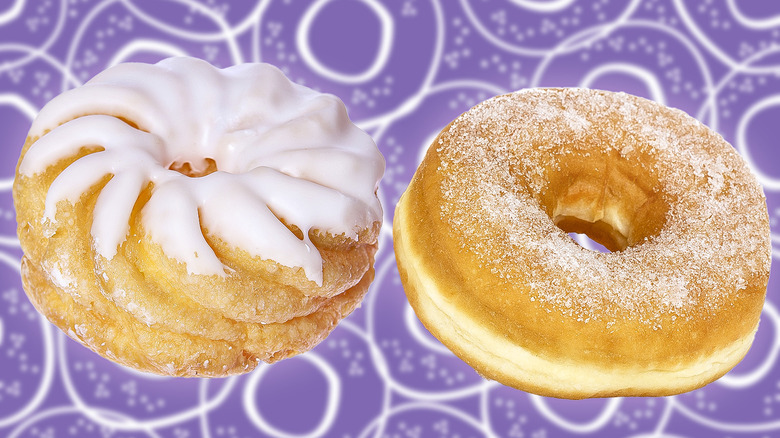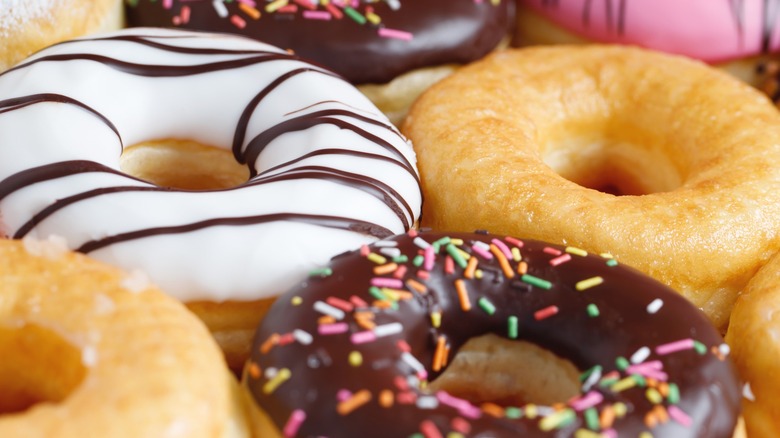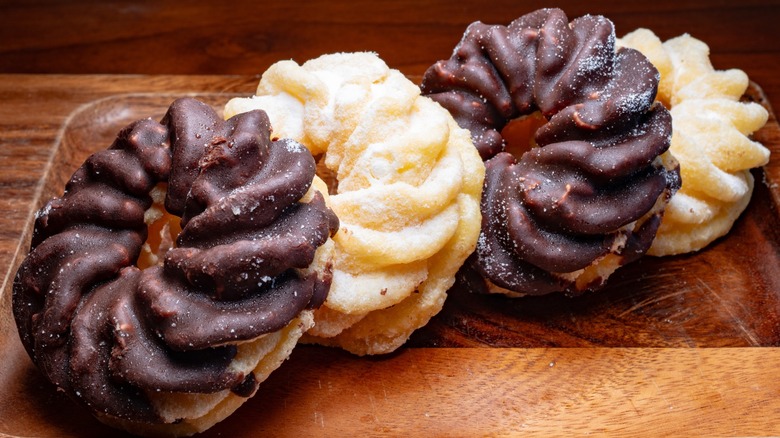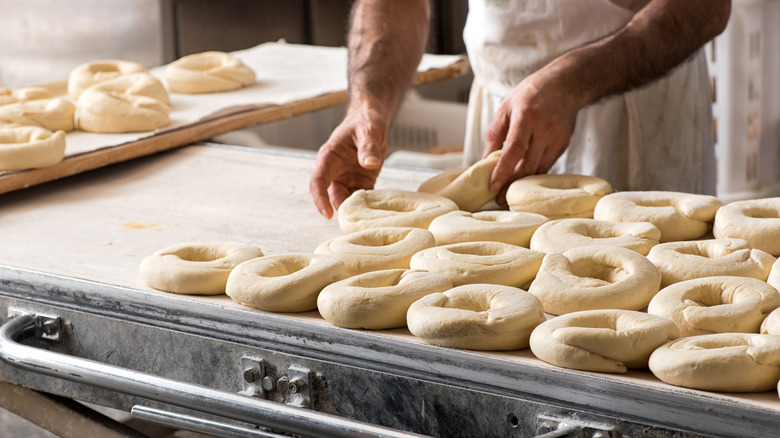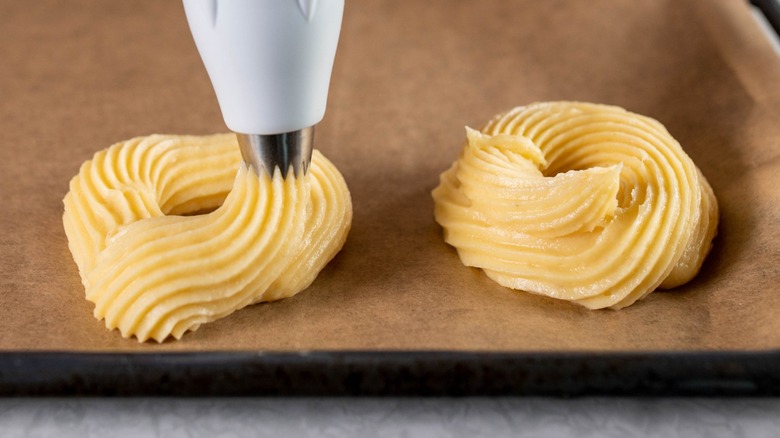What Truly Sets Crullers Apart From Classic Donuts
Often the best way to class-up a type of food is to infuse a bit of French. Thus, the American donut makes way for the French cruller. It worked so well at Dunkin' — which popularized the pinwheel-shaped pastry cruller throughout the United States — that when branches began to drop the item in the late 2000s, enough outrage ensued to spawn online petitions and cruller quests. That's because French crullers stand apart from classic donuts in a number of delicious ways.
French crullers use a different type of dough than standard donuts, which gives them a unique taste and also changes their texture. While classic donuts are either puffy or cakey, French crullers thread the needle between crispy and moist, in part thanks to their hollow, airy insides. This also makes them lighter than donuts, both in the hand and belly — and often when it comes to flavor, too. Furthermore, while classic donuts typically have a smooth surface, French crullers are ridged and twisted like a turning wheel.
What are classic donuts?
Donuts may be the true spirit animal of the United States. Developed by early Dutch settlers, who packed various fruits and nuts inside fried "oil cakes," the donut once accompanied many sailors out to sea as a nutritious foodstuff. In fact, it was one Maine ship captain named Hansen Gregory who famously added the hole in 1847 — so the story goes — because the center of the cake would often remain raw after cooking. Clearly, the idea stuck and became part of the mass production of donuts that began after World War 1, with the country's first donut-making machine being invented by Adolph Levitt in 1920. Today, the donut is as much an icon of American culture and society as the bald eagle and flag.
Both donuts and crullers use essentially the same base ingredients: eggs, butter, flour, sugar, and milk. However, the portions and preparation methods of these ingredients change according to the type of donut you are making. To add flavor and sweetness, as well as change the texture, other ingredients are almost always added, either into the dough or as a topping, like with glazed donuts. Cream and jelly can also be injected into a cavity in the center of donuts without holes, harkening back to the original Dutch oil cakes. The world's top chefs have upped the ante further by making the donut a new canvas for culinary visions — as evidenced by David Chang's pan-fried donut, which is topped with vanilla bean ice cream — and other favorite donut recipes.
What are crullers?
In the world of donuts, crullers tend to refer to the French-style version that's so popular today. While the cruller is unmistakably a donut in form — with a ring and central hole — it differs in several ways. Firstly, the French cruller draws from the cooking traditions of its namesake country, echoing other French pastries like cream puffs, éclairs, profiteroles, and beignets. A single bite will reveal the difference this makes in both flavor and texture.
It primarily has to do with the type of dough used, pâte à choux, which is different from that used in classic donuts and more like a stretchy paste. In fact, the dough is often piped into shape from a bag like a cake decoration rather than being shaped by hand or machine, as is done with classic donuts. It's the piping that gives French crullers their distinctive pinwheel shape and ridges. While the French-style version dominates the current donut market, it's not the only kind of cruller in the mix.
In fact, the name "cruller" is Dutch — from the word "krullen," which means "to curl." Dutch and German versions, available in places like Milwaukee, are not ring-shaped but oblong. Nor are they made from choux dough. Instead, they use more traditional bread ingredients to create a denser, more cake-like pastry. Another cruller version hand-twists the dough into a long, oblong shape — like a lock of braided hair — and covers it in cinnamon and sugar. In fact, this was the Dunkin' version of a cruller until 2003, when it was discontinued.
Classic donuts are made with cake or yeasted dough
Essentially, there are two kinds of classic donuts: cake and yeasted. The first is the heavier and denser of the two because cake donuts leaven the dough chemically with baking power and baking soda. As a result, they don't form as much gluten or trap a lot of carbon dioxide, making them dense and firm. While the dough is relatively easy to make by simply combining the ingredients in a mixing bowl and blending, the shaping and frying gets a bit more challenging. After chilling, the dough is rolled into a sheet with a pin and then circles are cut out, with even smaller circles removed from the center to form the donut hole. From there, the raw donuts are ready to fry.
The second type of donut dough depends on yeast — a living organism — for its shape, texture, and taste. The yeast is added to the mix instead of baking powder or baking soda, where it begins to consume the sugar and starch. This produces carbon dioxide gas, which puffs up the dough during "prooving," or letting the dough rest. From there, the yeasted dough used in classic donuts is then intensively kneaded to form the gluten that traps the gas inside the donut and produces its signature chewy, airy texture. As you might have guessed, Krispy Kreme donuts are made with yeasted dough. After that, the dough is rolled and rings are punched out before frying, just as with cake donuts.
Crullers are made with pâte à choux dough
French crullers use the shockingly easy to make pâte à choux dough that is far lighter and more delicate than yeasted or cake donut dough. This is largely because choux (pronounced "shoe") incorporates a lot of egg into the mix, creating more of a paste than a dough — it's the same dough used for traditional choux pastries like cream puffs and éclairs. This is then piped with a bag into rings, which are then placed in the hot oil, where they puff and raise. The result is a donut that's crispy on the outside but hollow and airy inside. The greater moisture in cruller dough compared to that of cake and yeasted donuts also becomes part of the flavor profile, as does the high egg content.
Choux dough also tends to eschew major flavoring adjuncts, such as fruit and chocolate, which are often added directly into the dough for cake and yeasted donuts. With French crullers, flavor enhancers more often come in the light sugar, vanilla, or lemon glaze drizzled on top. Nor do French crullers generally inject any creams or jellies into the hollow center. However, as with cake and yeasted donuts, flavor options are expanding, especially as the ridges created by choux piping make a tempting place for chefs to fill, as is seen in a lemon thyme version in Boston that comes with a framboise glaze.
